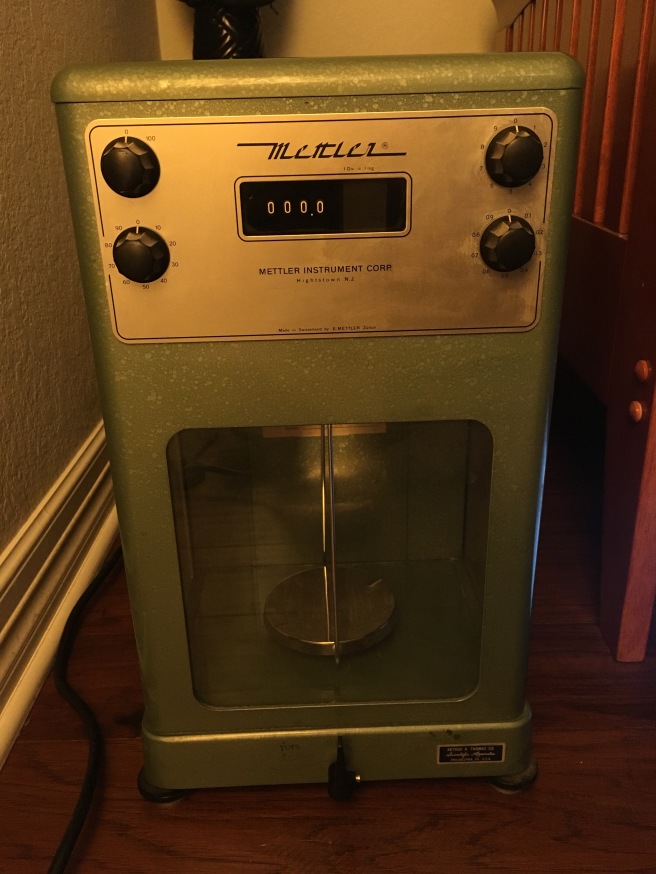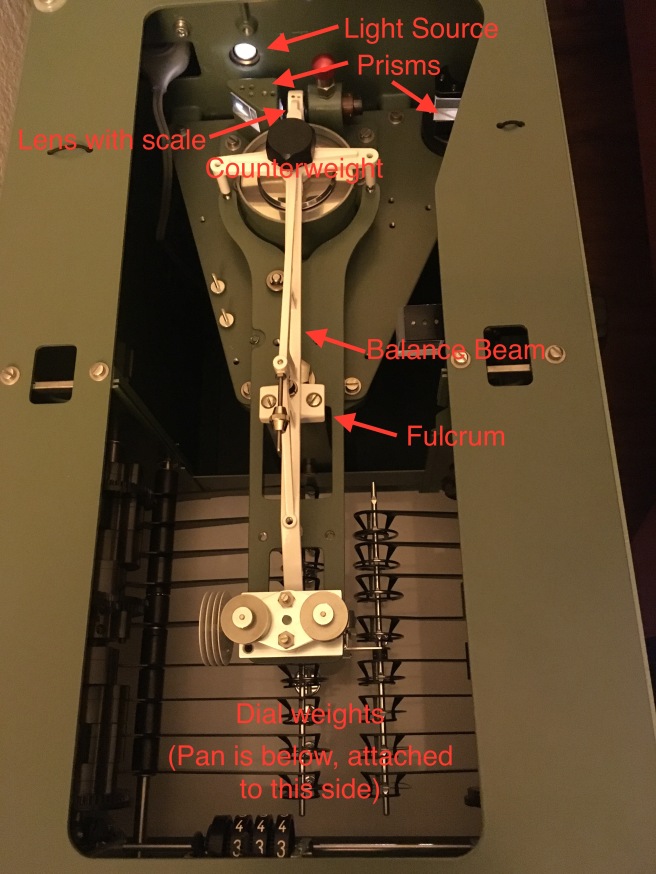Yesterday I purchased a vintage Mettler balance, circa 1961, if I estimate correctly from what little information I can find about them. It is the B5 model, which was first released in 1955, and manufactured through the 60s. Official Mettler service for them was discontinued in 1972, though it appears they had already stopped selling them by then. It measures to the .0001 gram, which is more precise than what I need right now. As long as it keeps working, I should never need to buy another balance!
After I got it home, I leveled out its feet, turned it on, and found that the display wasn’t aligned.  A view of the misaligned display
A view of the misaligned display
Seeing this, I decided to open up the top (which pops right off, no screws necessary) and see if I could diagnose the problem with my limited knowledge of these balances and some logical reasoning.

Top view with the lid off. Annotated.
Balances like this have more in common with old timey double pan balances than with modern analytical balances. The heart of this balance is the white balance beam that runs down the middle. On the back end of it is a large counterweight, and on the front end is the pan and the set of dial weights. The counterweight equals the mass of the pan plus the combined mass of all of the dial weights.
When weighing an object, the object is placed in the pan, and the dials are turned to remove weights from the pan until equilibrium is reached. The set of weights covers through the tenths of a gram, and the last three decimal digits are read off of the display once the rough mass is dialed in. This is where it gets interesting.
The display is backlit by a lightbulb all the way in the back of the machine. Light from this bulb shines through a prism, which directs it through a lens set in the balance beam on which a scale is printed. The light is then directed through another prism and projected onto the screen at the front of the balance, so that the scale can be easily read. The slightest motion of the pan sends the scale flying. A moveable prism, adjusted by the knob on the side, is used to finely tune the balance, by setting the projected scale even with the printed zero line on the display when the pan is empty.
I figured out that one of the stationary prisms inside was slightly misaligned, which was why the display didn’t look right. One quick adjustment later and it was good to go. Reading of a 5 gram standard weight. 5.0000 grams, +/- .0001 g.
Reading of a 5 gram standard weight. 5.0000 grams, +/- .0001 g.
I’m still trying to figure out how exactly to read the last decimal digit, though since that’s way more precision than I need, I’m not going to bother with it. Having a balance that accurately measures masses in milligrams is already enough for me!
It works like a Vernier Scale.
The line just below the Right hand 0 mark is how you read the first two points, then where the gradation marks line up perfectly with the right hand scale gives you the last digit.
So your scale is currently reading 5.0003.
(0 line on the right is just above the 00 line on the left. The markings on the 00 scale line up perfectly with the 3 on the right scale. Hence 5.0003g)
LikeLike
Thanks for posting this!!! I had gotten one poorly shipped and could not figure out where the weights with the white discs was supposed to go. Now I just need to figure why my bulb isn’t getting any electricity
LikeLike
This device contains a Radium226 static eliminator. Be careful.
LikeLike
I was curious about that actually. I read somewhere that these old balances usually did, but I couldn’t find any info about which part of it actually contains the radium, and I don’t have a Geiger counter to poke around on it.
LikeLike
My brother has an old Geiger counter that might be working. I recall hearing that an old marble sized Vaseline glass bead can be used to test the meter’s calibration. I have a number of the beads and will attempt to check the balance out ASAP.
If this was a common practice, was the radiological material generally shielded?
If I am able to accurately test mine I will post an update of any findings
LikeLike
I was interested to see your information about the B5 balance, although I notice it was posted a couple of years ago. I used a B5 for over 30 years in the packaging laboratories I supervised. We replaced it in the 1990′ s with electronic balances, and the trusty B5 was retired and was headed for the scrap dealer. I couldn’ t bear to see it thrown out, so I took it home and used to use it occasionally for a postage scale, a very accurate one ! This one was equipped with a Mettler supplied magnifier on the display to enable easy reading of the last digit. I had not heard of the presence of the Radium static eliminator. If there was any appreciable amount of radiation from it there were certainly a lot of people exposed to it from this particular balance, as it was used by hundreds of lab personnel through the years.
LikeLike